DCN
-
Official Full Name
decorin
-
Overview
The protein encoded by this gene is a small cellular or pericellular matrix proteoglycan that is closely related in structure to biglycan protein. The encoded protein and biglycan are thought to be the result of a gene duplication. This protein is a component of connective tissue, binds to type I collagen fibrils, and plays a role in matrix assembly. It contains one attached glycosaminoglycan chain. This protein is capable of suppressing the growth of various tumor cell lines. There are multiple alternatively spliced transcript variants known for this gene. This gene is a candidate gene for Marfan syndrome. [provided by RefSeq, Jul 2008] -
Synonyms
DCN; decorin; CSCD; PG40; PGII; PGS2; DSPG2; SLRR1B; PG-S2; bone proteoglycan II; decorin proteoglycan; proteoglycan core protein; small leucine-rich protein 1B; dermatan sulphate proteoglycans II;
- Recombinant Proteins
- Cell & Tissue Lysates
- Protein Pre-coupled Magnetic Beads
- Bovine
- Chicken
- Human
- Mouse
- Rat
- Sheep
- Zebrafish
- CHO
- E. coli
- E.coli
- HEK293
- HEK293T
- Human Cell
- In Vitro Cell Free System
- Insect Cell
- Mammalian Cell
- Mammalian cells
- Sf21 Insect Cell
- Wheat Germ
- Yeast
- C
- His
- Fc
- GST
- His (Fc)
- Avi
- His|SUMO
- Myc
- DDK
- Myc|DDK
- N/A
- N
- hFc
- SUMO
- T7|His
- Background
- Quality Guarantee
- Case Study
- Involved Pathway
- Protein Function
- Interacting Protein
- DCN Related Articles
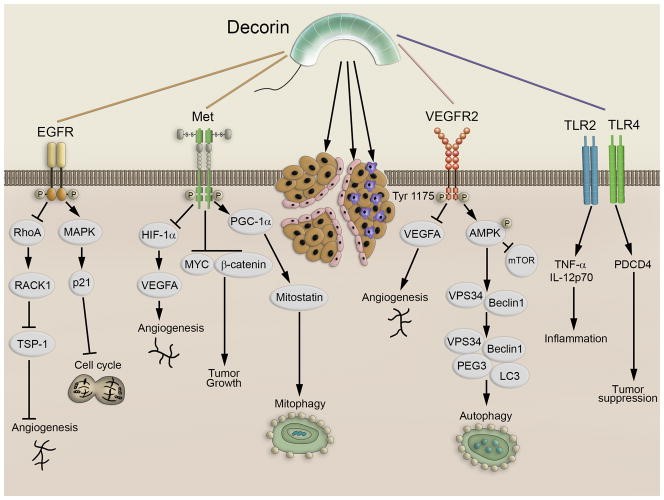
Fig1. Decorin exhibits promiscuity in its ability to alter tumorigenesis via regulation of angiogenesis, autophagy, and inflammation. (Liliana Schaefer, 2017)
What is DCN protein?
DCN (decorin) gene is a protein coding gene which situated on the long arm of chromosome 12 at locus 12q21. The protein encoded by this gene is a small cellular or pericellular matrix proteoglycan that is closely related in structure to biglycan protein. The encoded protein and biglycan are thought to be the result of a gene duplication. This protein is a component of connective tissue, binds to type I collagen fibrils, and plays a role in matrix assembly. It contains one attached glycosaminoglycan chain. This protein is capable of suppressing the growth of various tumor cell lines. The DCN protein is consisted of 359 amino acids and its molecular mass is approximately 39.7 kDa.
What is the function of DCN protein?
DCN proteins can bind and inhibit the activity of a variety of growth factors and cytokines, thereby regulating cell growth and differentiation. It can also promote the proliferation and migration of fibroblasts, vascular endothelial cells and other cells, accelerate tissue repair and regeneration. Can eliminate free radicals, reduce oxidative damage. It can affect the function of immune cells such as T cells and B cells and regulate immune response.
DCN Related Signaling Pathway
Decorin proteins can bind and inhibit the activity of TGF-β receptors, thereby blocking the conduction of TGF-β signaling pathways. Decorin proteins can bind and activate the Wnt/β-catenin signaling pathway, thereby promoting cell proliferation and differentiation. Decorin protein can bind and inhibit the activity of BMP receptor, thus blocking the conduction of BMP signaling pathway. Decorin proteins can bind and activate ERK signaling pathways, thereby promoting cell proliferation and differentiation.
DCN Related Diseases
DCN is associated with a variety of organ diseases, including kidney, liver, cardiovascular diseases, such as liver fibrosis, cirrhosis, glomerulosclerosis, renal interstitial fibrosis, atherosclerosis, myocardial infarction, etc. Abnormal DCN is also associated with tumor development.
Bioapplications of DCN
DCN can promote cell proliferation, differentiation and migration, and accelerate tissue repair and regeneration. As a result, several treatments for tissue repair and regeneration have successfully harnessed the function of the DCN protein. It's also used for cartilage repair.
High Purity
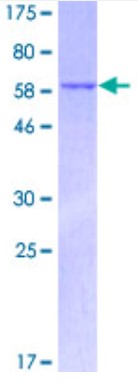
Fig1. SDS-PAGE (DCN-2398H) (PROTOCOL for western blot)
.
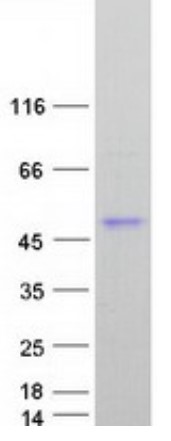
Fig2. SDS-PAGE (DCN-6518H) (PROTOCOL for western blot)
Case Study 1: Tze-Hong Wong, 2020
Aging impairs the IGF-I signaling of bone marrow mesenchymal stem cells (bmMSCs), but the mechanism is unclear. Here, the researchers found that the ability to auto-phosphorylate IGF-I receptor (IGF-IR) in response to IGF-I was decreased in the bmMSCs of aged donors. Conversely, data showed that decorin (DCN) expression was prominently increased in aged bmMSCs, and that under IGF-I treatment, DCN knockdown in serum-starved aged bmMSCs potentiated their mitogenic activity and IGF-IR auto-phosphorylation, whereas DCN overexpression in serum-starved adult bmMSCs decreased both activities. Co-immunoprecipitation assays suggested that IGF-I and DCN bound to IGF-IR in a competitive manner. Online MethPrimer predicted 4 CpG islands (CGIs) in the introns of DCN gene. RT-qPCR and bisulfite sequencing showed that dimethyloxalylglycine, an inhibitor of DNA demethylation, increased DCN mRNA expression and CGI-I methylation in adult bmMSCs, whereas 5-aza-2'-deoxycytidine, a DNA methylation inhibitor, decreased DCN mRNA expression and CGI-I methylation in aged bmMSCs, and ultimately enhanced the proliferation of serum-starved aged bmMSCs under IGF-I stimulation.
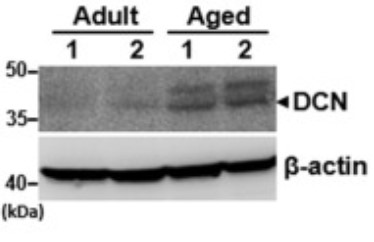
Fig1. Western blot analyses of DCN levels. Representative blots of the DCN levels in the Aged-1, Aged-2, Adult-1, and Adult-2 cells are shown.
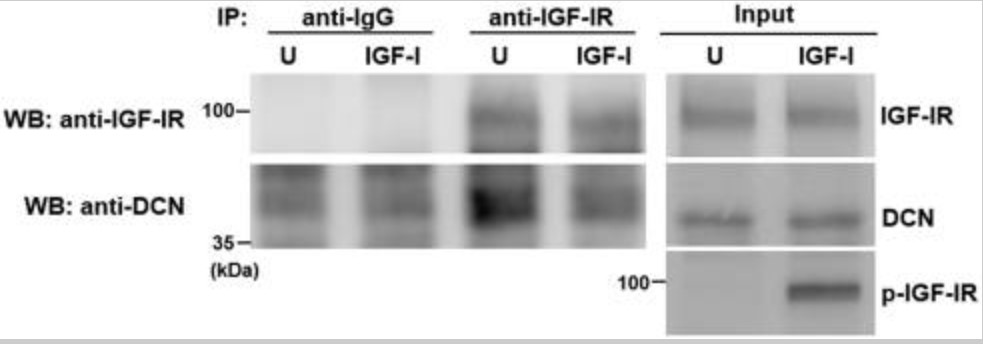
Case Study 2: Pinki Nandi, 2018
The origin and regulation of stem cells sustaining trophoblast renewal in the human placenta remain unclear. Decorin, a leucine-rich proteoglycan restrains trophoblast proliferation, migration/invasiveness and endovascular differentiation, and local decorin overproduction is associated with preeclampsia (PE). Here, the researchers tested the role of decorin in human trophoblast stem cell self-renewal and differentiation, using two models: an immortalized first trimester trophoblast cell line HTR-8/SVneo (HTR) and freshly isolated primary trophoblast (p-trophoblast) from early first trimester (6-9 weeks) placentas. Self-renewal capacity was measured by spheroid forming ability of single cells on ultra-low attachment plates for multiple generations. Markers of embryonic stem (ES) cells, trophoblast stem (TS) cells and trophoblast were used to identify stem cell hierarchy. Differentiation markers for syncytial and extravillous (EVT) pathways were employed to identify differentiated cells. Bewo cells were additionally used to explore DCN effects on syncytialization. Results reveal that the incidence of spheroid forming stem-like cells was 13-15% in HTR and 0.1-0.4%, in early first trimester p-trophoblast, including a stem cell hierarchy of two populations of ES and TS-like cells. DCN restrained ES cell self-renewal, promoted ES to TS transition and maintenance of TS cell stem-ness, but inhibited TS cell differentiation into both syncytial and EVT pathways.
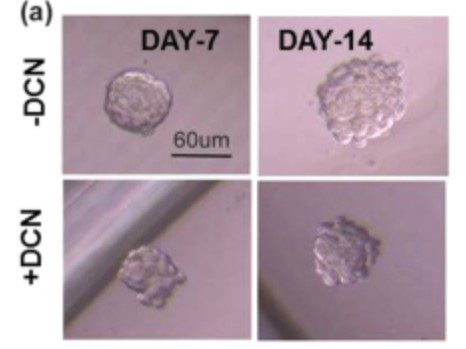
Fig3. Shows DCN effects (250 nM, having no effect on cell viability), on spheroid numbers and spheroid forming efficiency during the first generation.
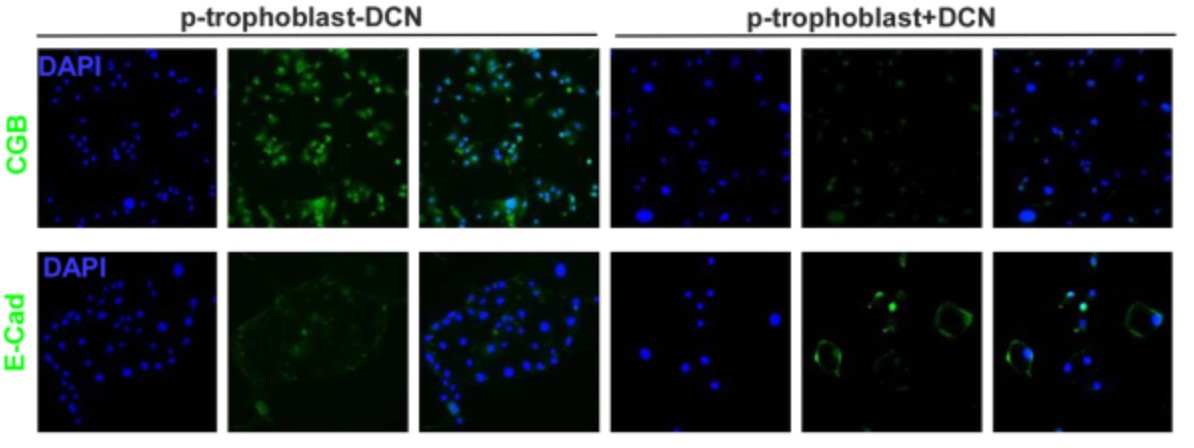
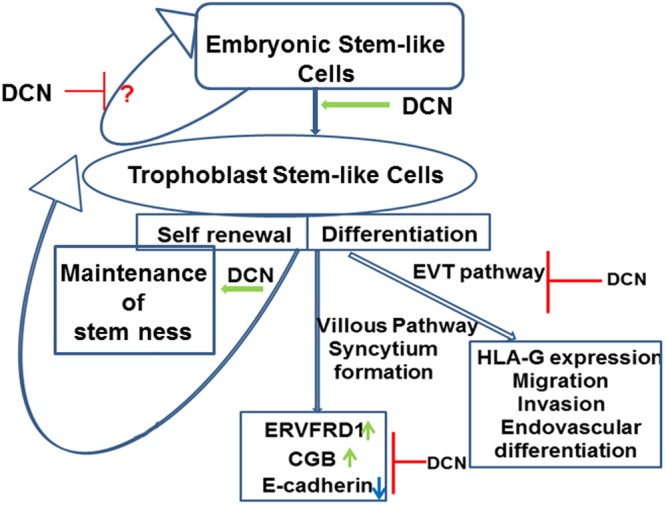
Fig1. Schema of proposed DCN action on stem cell hierarchy. (Pinki Nandi, 2018)
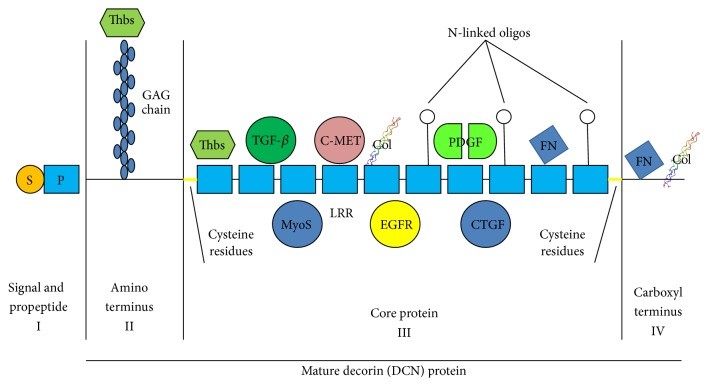
Fig2. Decorin interacts with multiple growth factor signaling pathways crucial for cancer growth. (Tero A H Järvinen, 2015)
DCN involved in several pathways and played different roles in them. We selected most pathways DCN participated on our site, such as A tetrasaccharide linker sequence is required for GAG synthesis, CS/DS degradation, Chondroitin sulfate biosynthesis, which may be useful for your reference. Also, other proteins which involved in the same pathway with DCN were listed below. Creative BioMart supplied nearly all the proteins listed, you can search them on our site.
| Pathway Name | Pathway Related Protein |
|---|---|
| A tetrasaccharide linker sequence is required for GAG synthesis | CSPG4;Gpc2;VCANB;GPC5;DCN;B3GAT2;BGNA;BGN;AGRN |
| CS/DS degradation | VCANB;VCAN;CSPG5;NCAN;BGNB;BCAN;DCN;BGNA;CSPG5B |
| Chondroitin sulfate biosynthesis | BGN;CSPG4;UST;VCANB;BGNA;BGNB;CSPG5;VCAN;CHST9 |
| Chondroitin sulfate/dermatan sulfate metabolism | GPC1A;GPC1B;NCAN;VCAN;Gpc2;AGRN;GPC5A;B3GAT2;UST |
| Defective B3GALT6 causes EDSP2 and SEMDJL1 | CSPG5;GPC5;VCAN;AGRN;BCAN;DCN;CSPG4;GPC6;BGN |
| Defective B3GAT3 causes JDSSDHD | GPC6;DCN;VCAN;CSPG4;CSPG5;BCAN;AGRN;GPC5;NCAN |
| Defective B4GALT7 causes EDS, progeroid type | AGRN;BGN;BCAN;CSPG5;GPC5;NCAN;VCAN;DCN;CSPG4 |
| Defective CHST14 causes EDS, musculocontractural type | BCAN;DCN;BGN;CSPG4;CSPG5 |
DCN has several biochemical functions, for example, collagen binding, extracellular matrix binding, glycosaminoglycan binding. Some of the functions are cooperated with other proteins, some of the functions could acted by DCN itself. We selected most functions DCN had, and list some proteins which have the same functions with DCN. You can find most of the proteins on our site.
| Function | Related Protein |
|---|---|
| collagen binding | PCOLCE2;CTSB;ITGA1;DCN;ACHE;PAK1;GPR56;PODN;GP6 |
| extracellular matrix binding | GPR56;BGN;VTN;VEGFA;SPOCK2;DCN;ITGA2B;CYR61;FBLN2 |
| glycosaminoglycan binding | SPOCK3;VIT;BGN;EPYC;SERPINA5;DCN;TGFBR2;SPOCK2;HABP2 |
| poly(A) RNA binding | SLBP;SLC3A2;SLIRP;UTP3;AGO1;LTA4H;KPNA2;ZC3H7A;HADHB |
| protein N-terminus binding | KCNIP2;RPS21;SYNGR3;EIF3E;PPP1CC;APTX;MORF4L1;ACTN4;CSNK2A2 |
DCN has direct interactions with proteins and molecules. Those interactions were detected by several methods such as yeast two hybrid, co-IP, pull-down and so on. We selected proteins and molecules interacted with DCN here. Most of them are supplied by our site. Hope this information will be useful for your research of DCN.
INS; INS; IGF2; INSR; FGF2; Fgf7; Fgf8; Fgf1
- Q&As
- Reviews
Q&As (7)
Ask a questionTargeted DCN delivery in breast cancer models reduces tumor growth.
DCN modulates TGF-β signaling, affecting fibrosis and cancer development.
Variations in DCN's glycosaminoglycan chains influence its growth factor interactions.
DCN gene silencing in fibroblasts alters extracellular matrix production and cell mobility.
Mechanical forces impact DCN's role in cardiac matrix organization and cell signaling.
Overexpression of DCN changes protein expression related to cell growth and matrix interactions.
DCN bound to collagen reveals binding sites essential for collagen structure.
Customer Reviews (3)
Write a reviewExcellent support for protein purification. Highly recommend this service.
Efficient protein expression, quick turnaround time, and reliable results.
Outstanding antibody validation; trustworthy for protein-protein interaction studies.
Ask a Question for All DCN Products
Required fields are marked with *
My Review for All DCN Products
Required fields are marked with *


